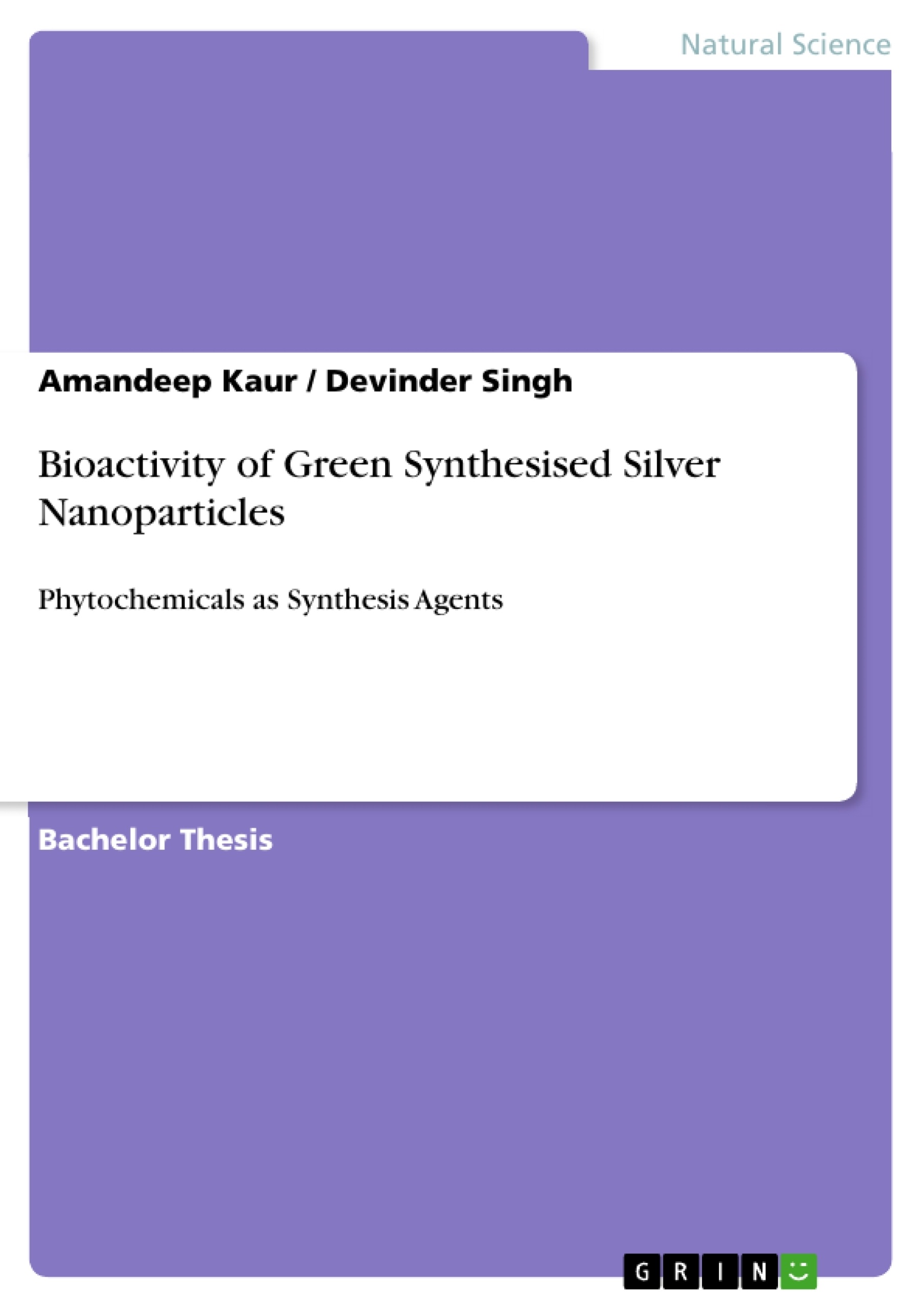Research and analysis of nanoparticles (NPs) synthesis and their biological activities has been expanded significantly in the recent years. The agents used for nanoparticles (NPs) synthesis are of organic (mainly carbon) and inorganic (metal ions like silver and gold) origin (Singh et al., 2010). Among these, silver (Ag) is the most preferred NPs synthesis agent due to its reported use in medical field as best topical bactericides from ancient times (Lavanya et al., 2013). The stable silver nanoparticles had been synthesized by using soluble starch as both the reducing and stabilizing agents (Shrivastava et al., 2012). So the concern of scientific community shifted towards ecofriendly, natural and cheaper method of NPs synthesis by using microorganisms and plant extracts (Mohanpuria et al., 2008). The use of plant materials for silver nanoparticles (AgNPs) is most popular due to its potential biological activities, easy availability and faster rate of synthesis there by cutting the cost of NP's synthesis (Huang et al., 2007 and Salam et al., 2012). The nanoparticles had been clinically used for infection, vaccines and renal diseases (Malhotra et al., 2010). The plant extract of petals of herbal species like Punica granatum, Datura metel (Chandran et al., 2011) and stem extracts of Svensonia hyderobadensis (Linga et al., 2011) had been effectively used for AgNPs synthesis and investigated for their antimicrobial activities.
Nanoparticles could be synthesized by various approaches like photochemical reactions in reverse micelles (Taleb et al., 1997), thermal decomposition (Esumi et al., 1990), sonochemical (Zhu et al., 2000) and microwave assisted process (Santosh et al., 2002 and Prasher et al., 2009). Nanocrystalline silver particles have found tremendous applications in the field of high sensitivity biomolecular detection and diagnostics (Schultz et al., 2000), antimicrobials and therapeutics (Rai and Yadav., 2009 and Elechiguerra et al., 2005) and micro-electronics (Gittins et al., 2000).
Acacia auriculiformis A. Cunn. is an exotic species that can survive in degraded lands in Thai savanna (Badejo et al., 1998). Besides its high adaptability in degraded savanna areas, A. auriculiformis is known for its nitrogen fixation property (Sprent and Parsons, 2000) enriching macrofaunal composition (Mboukou-Kimbatsa et al., 1998), low allelopathic effects (Bernhard-Reversat et al., 1999) and ability to pump nutrients from the subsoil (Kang et al., 1993).
Inhaltsverzeichnis (Table of Contents)
- CHAPTER 1 INTRODUCTION
- CHAPTER 2 METHANOL EXTRACT AND SILVERNANOPARTICLES
- CHAPTER 3 ACETONE EXTRACT AND SILVERNANOPARTICLES
- CHAPTER 4 WATER EXTRACT AND SILVERNANOPARTICLES
- CHAPTER 5 LITERATURE CITED
Zielsetzung und Themenschwerpunkte (Objectives and Key Themes)
This study explores the green synthesis of silver nanoparticles (AgNPs) using extracts from the medicinal plant Acacia auriculiformis. The primary objective is to characterize the synthesized AgNPs and assess their antimicrobial and antioxidant properties. The research aims to contribute to the development of environmentally friendly and effective antimicrobial agents.
- Green synthesis of silver nanoparticles using plant extracts.
- Characterization of silver nanoparticles using various spectroscopic techniques.
- Evaluation of antimicrobial activity of silver nanoparticles against various bacteria.
- Assessment of antioxidant properties of silver nanoparticles.
- Exploring the potential of Acacia auriculiformis as a source of bioactive compounds for nanomaterial synthesis.
Zusammenfassung der Kapitel (Chapter Summaries)
- Chapter 1: Introduction This chapter provides an overview of the research on nanoparticles synthesis and their biological activities, focusing on the use of silver as a preferred agent for nanoparticle synthesis. It highlights the growing interest in eco-friendly and cost-effective methods of nanoparticle synthesis using plant extracts. The chapter also introduces Acacia auriculiformis as a promising source of bioactive compounds for nanoparticle synthesis and outlines the specific objectives of the study.
- Chapter 2: Methanol Extract and Silver Nanoparticles This chapter details the synthesis of silver nanoparticles using methanol extract of Acacia auriculiformis. It describes the characterization of the synthesized nanoparticles using UV-Vis spectroscopy, FTIR spectroscopy, PL spectroscopy, and XRD spectroscopy. The chapter also investigates the antimicrobial activity of the nanoparticles against various bacterial strains.
- Chapter 3: Acetone Extract and Silver Nanoparticles This chapter focuses on the synthesis and characterization of silver nanoparticles using acetone extract of Acacia auriculiformis. It follows a similar approach as Chapter 2, analyzing the properties and antimicrobial activity of the nanoparticles.
- Chapter 4: Water Extract and Silver Nanoparticles This chapter examines the synthesis and characterization of silver nanoparticles using water extract of Acacia auriculiformis. It continues the investigation of the nanoparticles' properties and antimicrobial activity, comparing the results with those obtained using methanol and acetone extracts.
Schlüsselwörter (Keywords)
The key focus of this research lies in the green synthesis of silver nanoparticles using plant extracts, particularly those from Acacia auriculiformis. This involves exploring the antimicrobial and antioxidant properties of the synthesized nanoparticles, contributing to the development of eco-friendly and effective antimicrobial agents. The research delves into the bioactivity of these nanoparticles, their characterization using various spectroscopic techniques, and their potential applications in fields such as medicine and biotechnology.
- Quote paper
- Dr Amandeep Kaur (Author), Dr Devinder Singh (Author), 2013, Bioactivity of Green Synthesised Silver Nanoparticles, Munich, GRIN Verlag, https://www.grin.com/document/295643



